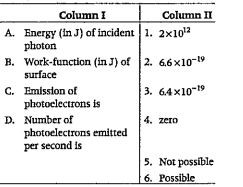A beam of light has three wavelengths 4144Å, 4972Å and 6216Å with a total instensity of 3.6×10−3Wm−2 equally distributed amongst the three wavelengths. The beam falls normally on an area 1.0cm2 of a clean metallic surface of work function 2.3 eV. Assume that there is no loss of light by reflection and that each energetically capable photon ejects on electron. Calculate the number of photo electrons liberated in two seconds.
Step by step video & image solution for A beam of light has three wavelengths 4144 Å, 4972 Å and 6216 Å with a total instensity of 3.6 xx 10^(-3) Wm^(-2) equally distributed amongst the three wavelengths. The beam falls normally on an area 1.0 cm^2 of a clean metallic surface of work function 2.3 eV. Assume that there is no loss of light by reflection and that each energetically capable photon ejects on electron. Calculate the number of photo electrons liberated in two seconds. by Physics experts to help you in doubts & scoring excellent marks in Class 12 exams.
Updated on:21/07/2023Topper's Solved these Questions
- PHOTOELECTRIC EFFECT AND MATTER WAVESBOOK - PHYSICS GALAXY - ASHISH ARORACHAPTER - PHOTOELECTRIC EFFECT AND MATTER WAVESEXERCISE - Discussion question
50 Videos
- PHOTOELECTRIC EFFECT AND MATTER WAVESBOOK - PHYSICS GALAXY - ASHISH ARORACHAPTER - PHOTOELECTRIC EFFECT AND MATTER WAVESEXERCISE - Conceptual MCQ
27 Videos
- NUCLEAR PHYSICS AND RADIOACTIVITYBOOK - PHYSICS GALAXY - ASHISH ARORACHAPTER - NUCLEAR PHYSICS AND RADIOACTIVITYEXERCISE - Concptual MCQs
48 Videos
- THERMODYNAMICS LAWS & SPECIFIC HEATS OF GASES BOOK - PHYSICS GALAXY - ASHISH ARORACHAPTER - THERMODYNAMICS LAWS & SPECIFIC HEATS OF GASES EXERCISE - Practice Exercise 3.4
11 Videos
Similar Questions
A beam of light has three wavelengths 4144Å, and 6216Å with a total instensity of 3.6×10−3Wm−2 equally distributed amongst the three wavelengths. The beam falls normally on an area 1.0cm2 of a clean metallic surface of work function 2.3 eV. Assume that there is no loss of light by reflection number of photoelectrons liberated in two seconds.
View SolutionA beam of light has three λ,4144Å,4972Åand6216Å with a total intensity of 3.6×10−3Wm−2 equally distributed amongst the three λ. The beam falls normally on an area 1.0cm2 of a cleam metallic surface of work function 2.3 eV. Assume that there is no loss of light by reflection etc. Calculate the no. of photoelectrons emitted in 2 sec, in scientific notation,x×10y find the value of y.
View Solution
Knowledge Check
A beam of light has three λ,4144Å,4972Åand6216Å with a total intensity of 3.6×10−3Wm−2 equally distributed amongst the three λ. The beam falls normally on an area 1.0cm2 of a cleam metallic surface of work function 2.3 eV. Assume that there is no loss of light by reflection etc. Calculate the no. of photoelectrons emitted in 2 sec, in scientific notation,x×10y find the value of y.
A2×109B1.075×1012C9×108D3.75×106A beam of light has two wavelengths 4,972Åand6,216Å with a total intensity of 3.6×10−3Wm−2 equally distributed among the two wavelengths . The beam falls normally on an area of 1cm2 of clean metallic surface of work function 2.3 eV . Assume that there is no loss of light by reflection and that each capable photon ejects one electron. The number of photoelectrons liberated in 2 s is approximately
A6×1011B9×1011C11×1011D15×1011A light beam of intensity 3.3×10−3jm2-s and wavelength 6000A∘ falls normally on a photosensitive surface of area 2cm2 and work function 2.0 eV assuming that there is no light loss due to reflection match the result given in column II for the physical quantities given in column I
 A
A B
B C
C D
D
A beam of light has three wavelengths 4000Å,5000Å,6000Å with a total intensity 3×10−3W/m2 equally distributed amongst the three wavelenth. The beam falls normally on an area 2cm2 of clean metallic surface of work function 2.4eV. Calculate photo current. (Assume each energetically suitable photon emits one electron)
View SolutionA beam of light has an power of 144 W equally distributed among three wavelengths of 4100Å, 4960Å and 6200Å. The beam is incident at an angle of incidence of 60° on an area of 1cm2 of a clean sodium surface, having a work function of 2.3 eV.Assuming that there is no loss of light by reflection and that each energetically capable photon ejects a photoelectron, find the saturation photocurrent. (Take hc/e=12400eVÅ)
View SolutionA beam of light consists of four wavelength 4000Å,4800A,6000A and 7000Å, each of intensity 1.5×10−3Wm−2. The beam falls normally on an area 10−4m2 of a clean metalic surface of work function 1.9eV. Assuming no loss of light energy (i.e. each capable photon emits one electron) calculate the number of photoelectrons liberated per second.
View SolutionA light source, emitting there wavelengths 500nm, 600nm and 700 nm, has a total power of 10−3W and a beam diameter 2×10−3m. The density is distributed equally amongst the three wavelength. The beam shines normally on a metallic surface of area on 10−4m2 and having a work function of 1.9 eV. Assuming that each photon liberates an electron, calculate the charge emitted per unit area in one second.
View SolutionLight of wavelength 3000 Å falls on a metal surface having work function 2.3 eV. Calculate the maximum velocity of ejected electrons.
(Planck's constant , h=6.63×10−34 J.s. , velocity of light c=3×108m/s , mass of an electron = 9.1×10−31 kg )
View Solution
